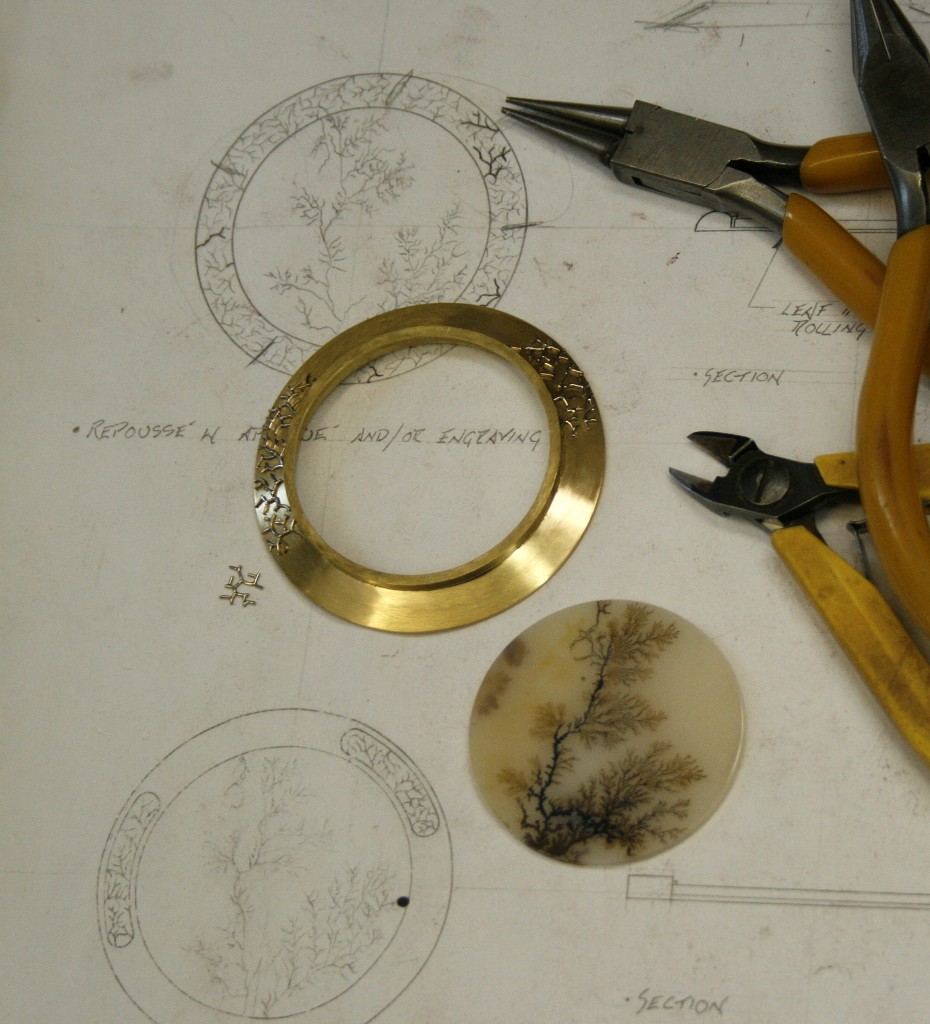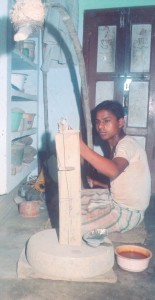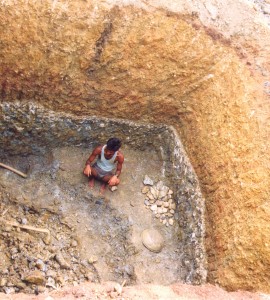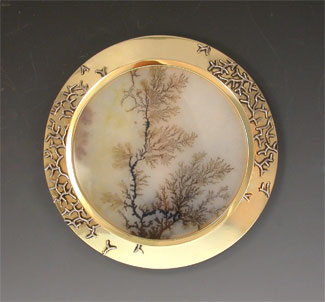©2010
Hand & Eye:
The creation of a work of art is a process. Sketches are made, revised and a final design decided upon. However, during the course of the process, things change.
One of the larger questions in deciding on the final design for this pendant/brooch, was the complexity and placing of the appliques of white gold on the yellow gold surface of the pendant frame. These tiny branch like elements are meant to echo the natural pattern of dendritic inclusions in the agate itself (image left). The formation and cutting of this rare type of agate is the subject of the article below by Tarun Adlakah.
Both the designer, Michael Corneau and I agreed that too much applique would be too fussy. The question was, how do you minimize this design element without the result looking half-done. Michael came up with a couple of ideas, once the piece was in process figured out a better design which neither of us had discussed.
The finished piece was completely handmade from sheet gold using a saw, hammer, torch and laser welder. This method, known as hand fabrication is the true “handmade” method. The term is tossed about pretty liberally and often used to describe one of a kind pieces made in wax then cast by the lost wax method (cire perdu), but in my view unless you work in the metal itself, the piece cannot be said to be truly handmade.
A majority of the tools used in this process are hundreds if not thousands of years old. Some of the tools, such as the bow-drill featured below can be seen on tomb paintings from ancient Egypt. The laser welder is a new and very expensive tool. It was invented about twenty years ago and allows for precise cold-joining. It is particularly useful for adding the tiny filigree like elements pictured above
Poetry In Stone
by Tarun Adlakha
There are many legends surrounding the discovery of these stones and are mostly fables but it was around 400 years ago that the first documented records of their occurrence can be traced back to. A chance discovery gave birth to this lapidary art that flourished in the reign of the Chandela King Chhatrasal.
There are two primary occurrences of these stones spread over an area of about 50 kms radius in West Central India. The primary occurrence is of secondary river bed deposits in one of the tributaries of the Narmada river that has been weathered down by water and is a regenerating source after the annual post monsoon floods and is often associated with the transparent and more finely imprinted stones while the second inland source is associated with the translucent stones which are again sub characterized according to the regional peculiarities and are mined from the grey green volcanic ash beds at the depths of 40-85 feet.
Chemically these agates are quartz nodules with atypical banding and occasional druzy hearts with a hardness of around 7 on the Moh’s scale. Some nodules have yellow skins though that is again not a typical feature. The impressions though are still a scientific debate though most opinions point to the purely inorganic depositions of iron, magnesium and tin ions while a smaller school of thought believes that these were organic material replaced by ion exchange process over millions of years by inorganic metal salts and agatized.
The cutting process despite the advent of the gem saws has still remained the same for the  last 400 years. The finally sorted stones are then sent to the master cutters who use a length of bow string coated with silicon carbide mounted on a wooden stand to slowly grind layer by layer until the dendrite bearing layer is reached. It is a painstaking process because the layers are very fine and the dendritic impressions even finer and not more than a few microns thick. One wrong stroke and a beautiful gem is ruined.
last 400 years. The finally sorted stones are then sent to the master cutters who use a length of bow string coated with silicon carbide mounted on a wooden stand to slowly grind layer by layer until the dendrite bearing layer is reached. It is a painstaking process because the layers are very fine and the dendritic impressions even finer and not more than a few microns thick. One wrong stroke and a beautiful gem is ruined.

